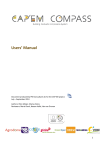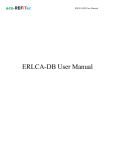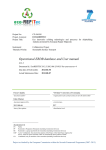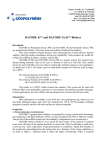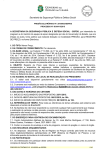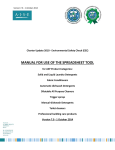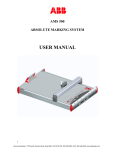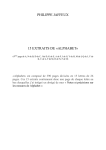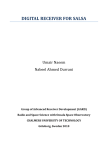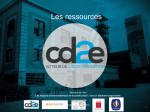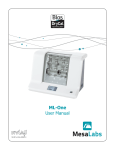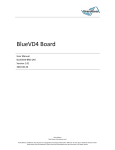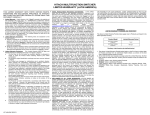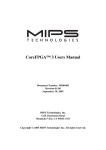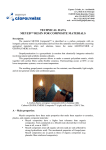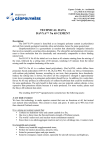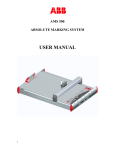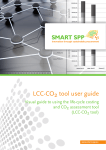Download Compass User`s Manual
Transcript
Users’ Manual Document produced by PRé Consultants bv for the CAP’EM project. July – September 2013 This version: June 2014 Authors: Ellen Meijer, Marisa Vieira Reviewers: Marie Darul, Naeem Adibi, Han van Drunen 1 CAP’EM COMPASS – Users’ Manual Table of Contents 1 INTRODUCTION 1 2 SEARCH 1 2.1 2.2 2.3 2.4 2.5 3 3.1 3.2 3.3 3.4 3.5 4 BUILDING ELEMENT PREFERENCES SEARCH RESULTS SELECTION COMPARE ENVIRONMENTAL IMPACTS SELECTING ENVIRONMENTAL IMPACTS OPTIONS GENERIC PRODUCTS TRANSPORT DECISION CONTEXT 4.1 DECISION SITUATIONS 4.2 TRADE OFFS 5 GLOSSARY 1 1 1 2 2 2 2 2 3 3 3 4 4 4 5 ii CAP’EM COMPASS – Users’ Manual 1 Introduction The CAP’EM Compass can be used to choose the right building products according to the user’s needs and compare their environmental impact. The results can be used to gain insight into different products and support the decision making process. This manual describes the functionality of the CAP’EM Compass. It covers how the tool can be used, how the results can be interpreted and explains some of the methodology behind the tool. All terms marked with an asterisk (*) are explained in the glossary in chapter 5. When you open the tool you see the Welcome page. Here, the operation and handling of the CAP'EM Compass are explained in short. Some help text is also included in the tool, which can be accessed through the sign. A FAQ list is also available through the link: http://www.capem.eu/capem/en/8431-faq.html 2 Search Ticking the 'Search' button in the Welcome screen will lead you to the Search screen. This screen allows you to search the database for products you want to compare. On the left, you can select the building element that you are interested in, for example an external wall or a flat roof, as well as a function and other criteria. The chosen criteria will filter the products in the database to show only those that match your search. 2.1 Building element On the top left in the Search screen, there is a section called Building Element. To start your product selection, a type of building element and a specific function need to be selected from a drop down menu. This filters the products in the database. The Element describes in what part of the building the product will be used, for example in the foundation or an external wall. A Function needs to be selected as well, for example provide lateral stability or thermal insulation. It is necessary to select the function of the products to have a fair comparison. The environmental impacts calculations will be made according to a functional unit linked to the building element function. It is of course possible that a product has several functions. For example an external wall needs to provide both load bearing capacity and thermal insulation. In that case you choose the one that is most relevant for your comparison, since a different amount of each product may be required to fulfil this function. Only products that are suitable for the selected Element and Function will be displayed in the results. 2.2 Preferences The Preferences section is located directly below the Building Element section. Here it is possible to further filter the results based on preferences you may have. This is not obligatory, but can help you further detail the list of materials. Click on the header to expand this section. 2.3 Search When you are looking for a specific product it is possible to use the Search function. This function will look for your search terms in the database of materials. When you have selected a Building Element, a Function and preferences, the search function will only look in the list of products that comply with your choices. 1 CAP’EM COMPASS – Users’ Manual 2.4 Results After selecting a Building Element, Function and preferences the products that match the selection will be shown on the middle part of the screen. The results are automatically sorted by name. When you want to know more about a material it is possible to click on its name. A window will be displayed containing detailed product information such as the product description, manufacturer information and technical data. The content displayed in this new window can be saved as a PDF file. 2.5 Selection You can select the products you are interested in by ticking the selection boxes on the left of their name. All selected products will appear in the Selected Building Elements list on the right side of the screen. It is important to select at least two products, since the tool is meant for comparison. If you completed your selection click the Compare button below the list of Selected Building Elements. Please note that all the environmental impacts are scored relatively. They are determined by setting the score of the product with the highest effect on a specific environmental impact at 100%. All other products are given scores relative to this 100% value. This is done for each type of environmental impact. As a result a score of 0% does not have to mean that there is no environmental impact. It just means that the impact on that effect is very low compared to the product l with the highest impact. It is also possible that there is a difference in impact between materials with the same relative score. To be able to draw a conclusion about the impact of products they need to be selected and compared in the next step. Also please note that the actual severity of the effect can be different for each of the environmental impacts, since the relative scores are calculated separately for each of the impacts. So it is not possible to say if a score of 50% on Human Health is better or worse than a score of 50% on Ecosystem Quality. 3 Compare The Compare screen allows you to compare the selected materials on several environmental impacts. The results can be displayed in both charts (default) and tables. 3.1 Environmental impacts After clicking the Compare button a default view of the environmental impact of the selected products is shown. The result is shown in three environmental impacts, which are preselected on the left of the screen, under Environmental Impacts: 1. 2. 3. Climate change is measured in the unit kg CO2 eq.* and shows the impact of the material on the changes in the global, average surface-air temperature and subsequent change of various climate parameters. Particulate matter is measured in the unit kg PM2.5 eq.* and shows the impact of the material on human health in general, but specifically on the heart and lungs.. Mineral, fossil and renewable resource depletion is measured in the unit kg Sb eq.* and shows the impact of the material on the depletion of resources. When you point the cursor at a column in the graph a textbox is shown with the name of the products, the environmental impact and the characterized score as a percentage. 3.2 Selecting environmental impacts It is possible to select one or more from 17 environmental impacts to get a more detailed comparison of the products and focus on what you consider being relevant decision criteria. These environmental impacts can be found on the left of the screen. Selecting one or more of these impacts (figure 1) can be done by ticking the box in front of it. This will adapt the chart with the default impacts. 2 CAP’EM COMPASS – Users’ Manual Impact Climate change* Ozone depletion* Human toxicity, cancer effects* Human toxicity, non-cancer effects* Particulate matter* Ionizing radiation* Photochemical ozone formation* Acidification* Terrestrial eutrophication* Freshwater eutrophication* Marine eutrophication* Freshwater ecotoxicity* Land use* Water resource depletion* Mineral, fossil & renewable resource depletion* Cumulative energy demand* Sequestered CO2 eq.* Figure 1 – specific impacts 3.3 Unit kg CO2 eq. kg CFC-11 eq. CTUh CTUh kg PM2.5 eq. kg U235 eq. kg C2H4 eq. molc H+ eq. molc N eq. molc P eq. molc N eq. CTUe kg C deficit m3 kg Sb eq. MJ kg CO2 eq. Options The box on the right side of the screen allows several additional actions. First of all it is possible to temporarily deselect products by unticking their boxes. This can be useful when you had initially selected a large number of products and want to inspect a few of them more closely. The deselected products remain in the list of building elements so they can easily be reselected. Below the list of building elements on the right there is an option to change your selection. Clicking here will bring you back to the search screen you used before. All your preferences are the same as when you left this screen so it is easy to add or remove materials. When you click Calculate again the settings in the compare screen remain the same as when you left it; only the products to be compared are changed. Another possibility is to click the Table View button. This will switch the displayed chart for a table. This table shows the actual scores of the products on the selected impacts instead of percentages. This table can also be copied to for example Excel to save the results. 3.4 Generic products A very useful option is the possibility of adding one or more generic products (conventional products) to the comparison. This is done by clicking the “+ Generic" button on the right side of the screen. A generic product that represents the same building element and function as those selected is added to the chart and table like all other selected products. Adding a generic product that is often used for the building element and function you selected allows you to see how this differs from using an eco-product. This makes it easier to assess differences between eco-products and conventional products. 3.5 Transport Another useful option is the possibility to include the transport of the products from the manufacturing plant to the building site in the comparison. When you click “+ Transport” in the box on the right side of the screen, a pop-up window appears. The destination of the products can be entered in this window, normally the building site where the products will actually be used. This is done by entering a country and the digits (and letters, for UK only) of a postal code. 3 CAP’EM COMPASS – Users’ Manual Since it is known where the products are produced (this information is included in the product datasheet), the transport distance to the entered location is automatically determined for each product. The default transport mode used will be a truck. If the product does not come from Europe, the transport from the country to Rotterdam harbour will be by freight ship. Further transport to the building site will be by truck. The impact caused by transport can be removed again by clicking "- Transport". Transport is only displayed accurately for the CAP’EM assessed products because the generic products have default manufacturing location information per country of origin. 4 Decision context After setting all the preferences for the comparison, such as the environmental impacts to compare on and a generic product and transport, the results can be interpreted. This can give valuable information in the decision making process. There are different situations that can occur, which are discussed below. 4.1 Decision situations There are several different situations possible when deciding what product to use. In the most basic situation you want to choose the product based on the overall environmental performance. In this case, you look at the three default environmental impacts for your decision. Please note that it is only possible to make an undebatable decision when one material has the lowest score on all three impacts. This is because it is unknown whether a score on one impact is better or worse than a score on another impact. Another option is that you don’t necessarily want the most environmental friendly product, but at least want to improve, compared to the generic products. In that case, adding one or more generic products to the comparison is very helpful. Again, it should suffice to look at the three default environmental impacts. Another possible situation is that you or your company finds a certain environmental impact more important than others, for exampleozone depletion. It that case, it is possible to just look at the effect of the materials on this environmental impact for your decision. In this situation, it is however useful to have a quick look at the three defaultenvironmental impacts as well. It is possible that a product performs well on your chosen environmental impact, but has a higher impact than other products on other environmental themes. 4.2 Trade offs In the ideal scenario there would be a product that performs better on each of the impacts you are looking at. A choice is easily made in that situation. However, often a trade-off will occur. In that case a product A is better on one impact, but product B is better on another. This is a difficult situation for decision makers. The first thing to do would be to look at how big the differences are. If product A scores is a lot better on one category and only a bit worse on another this could justify a choice for this material. Another option would be to look at a graph of all the specific impacts. This shows the scores of the products on 17 impact categories instead of three. These more detailed results give you more information to base the decision on. A final option would be to consider if there are any impacts you or your company find more important. This could favour the product that scores better on these impacts. There is no standard way of making decisions based on the environmental impact. The results can however give you more insight in the products, so you can make an informed decision. 4 CAP’EM COMPASS – Users’ Manual 5 Glossary Here all terms marked with an asterisk (*) are explained. Acidification Acidification is caused by direct outlets of acids or by outlets of gases that form acid in contact with air humidity and are deposited to soil and water. These acid depositions have negative impacts on natural ecosystems and the man-made environment including buildings.1 Climate change Climate change describes changes in the global, average surface-air temperature and subsequent change of various climate parameters. This effects things such as storm frequency and intensity, rainfall intensity and frequency of flooding. Climate change is caused by the greenhouse effect which is induced by emission of greenhouse gases into the air.1 Cumulative energy demand Cumulative energy demand describes the total amount of energy that is needed for the product. Freshwater ecotoxicity Freshwater ecotoxicity is the potential environmental toxicity of residues, leachate, or volatile gases that affect plants and animals. Ecotoxic substances alter the composition of the species of ecosystems, destabilizing it thereby and additionally threatening sensitive species in their existence.1 Freshwater eutrophication Freshwater eutrophication is generally associated with the environmental impacts of excessively high levels of nutrients in fresh water that lead to shifts in species composition and increased biological productivity, for example as algal blooms.2 Human toxicity, cancer effects Human toxicity, cancer effects describes the degree to which chemical substances elicit a deleterious or adverse effect (cancer) upon the biological system of a human exposed to the substance over a designated time period.1 Human toxicity, non-cancer effects Human toxicity, non-cancer effects describes the degree to which chemical substances elicit a deleterious or adverse effect (other than cancer) upon the biological system of a human exposed to the substance over a designated time period.1 Ionizing radiation Ionizing radiation has enough energy to break chemical bonds. It has the potential to damage DNA.3 Land use Land use is related to use (occupation) and conversion (transformation) of land area by productrelated activities such as agriculture, roads, housing, mining etc. Land occupation considers the effects of the land use, the amount of area involved and the duration of its occupation.1 Marine eutrophication Marine eutrophication is generally associated with the environmental impacts of excessively high levels of nutrients in marine water that lead to shifts in species composition and increased biological productivity, for example as algal blooms.2 Mineral, fossil & renewable resource depletion Resource depletion is caused by the consumption of mineral, fossil and renewable resources, thereby lowering their availability for future generations.1 Ozone depletion Ozone depletion refers both to the general progressive loss of ozone in the stratosphere, which has been occurring for the past three decades, and on a more localised scale the loss of ozone taking place over the polar regions at a greater rate, but on a seasonal basis.1 Particulate matter Particulate matter is made up of a number of components, including acids, organic chemicals, metals, and soil or dust particles. The size of particles is directly linked to their potential for causing health 5 CAP’EM COMPASS – Users’ Manual problems. Particles that are 10 micrometers in diameter or smaller can pass through the throat and nose and enter the lungs. Once inhaled, these particles can affect the heart and lungs and cause serious health effects.1 Photochemical ozone formation Photochemical ozone formation is caused by emissions that react with the light energy of the sun. Sequestered CO2 equivalent Sequestered CO2 equivalent describes the capture of CO2 and its long-term storage in the form of carbon, in biogenic resources. Terrestrial eutrophication Terrestrial eutrophication is generally associated with the environmental impacts of excessively high levels of nutrients on land that lead to shifts in species composition and increased biological productivity.2 Water resource depletion Water resource depletion is caused by the consumption of water resources, which lowers their availability for nature and future generations.3 1 2 3 United States Environmental Protection Agency, http://www.epa.gov/pm/ Baumann, H. and Tillman, A., The Hitch Hiker’s Guide to LCA, 2004 European Commission, Glossary (http://lca.jrc.ec.europa.eu/lcainfohub/glossary.vm) 6








